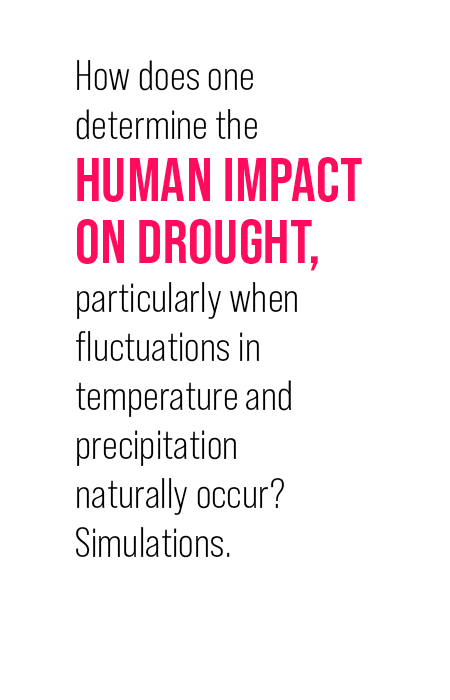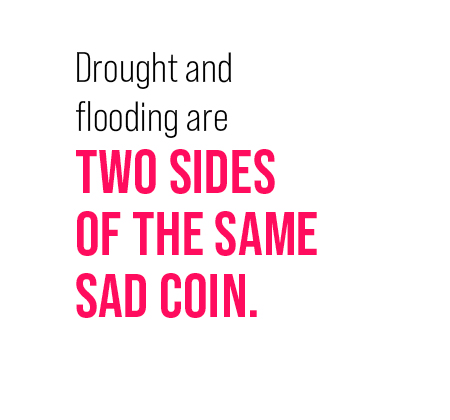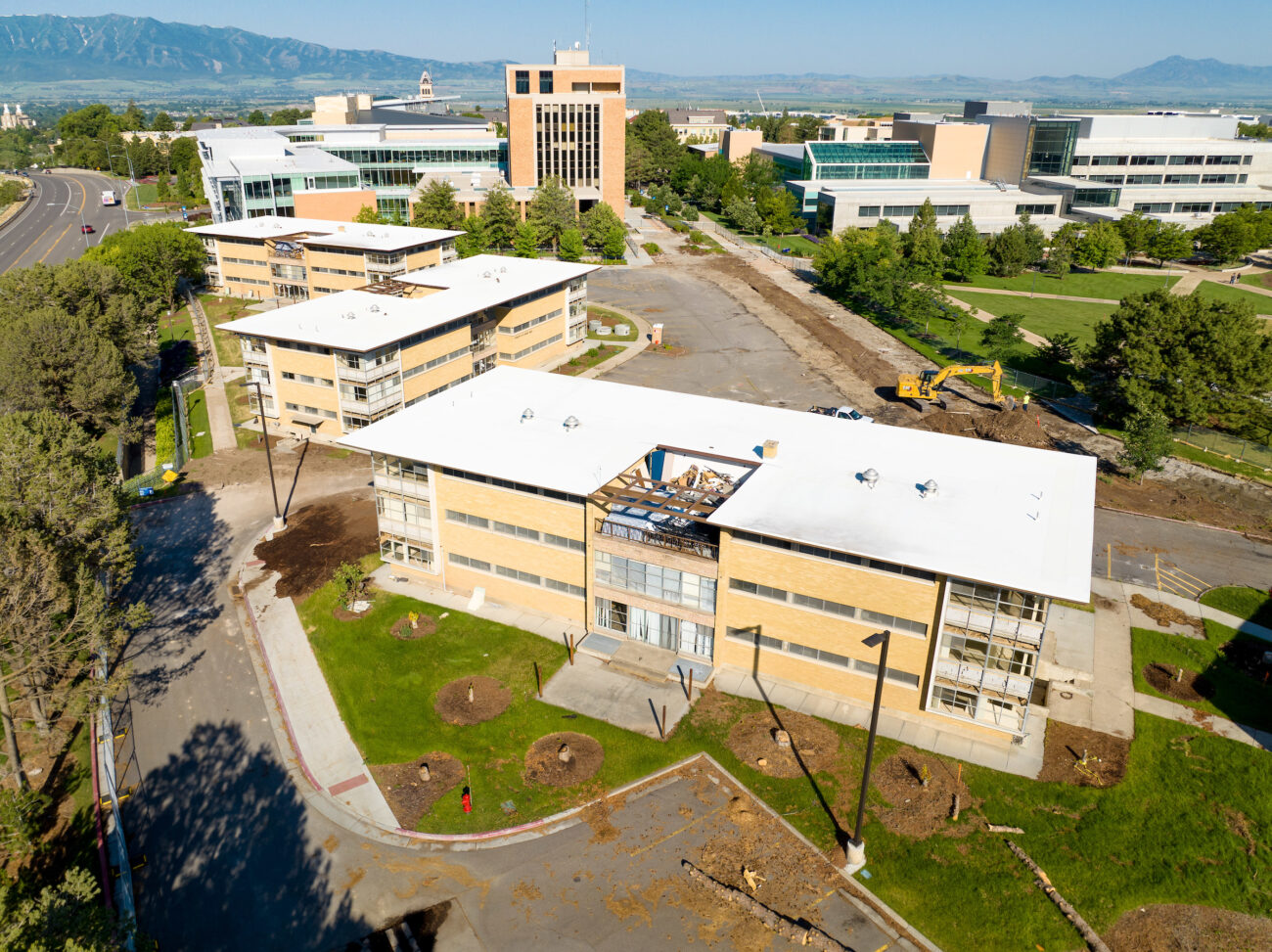The Human Impacts Affecting Western Drought

Drought isn’t something that Grace Affram worried about growing up.
“In Ghana, there are just a few places that have droughts,” she explains. “We have a lot of water — and we don’t really use it wisely.”
But she became fascinated with drought as an undergraduate and couldn’t shake her interest in the subject as a master’s student of earth system physics in Italy. A job posting by Wei Zhang, assistant professor in the plants, soils, and climate department at Utah State University, prompted her to email him for details. Soon after meeting over Zoom, Affram was touching down in Utah to begin her doctorate investigating the causes of drought in the American West.
“It just interests me to help,” she says. “I feel like I am trying to help people who don’t have water.”

Zhang moved to Utah from Iowa where he spent four years analyzing hydrological models and exploring a seemingly different problem — historic flooding events. He realized he could apply a similar methodology to understand drying trends.
“One interesting thing that I noticed is that when you look at the historical trend in precipitation across the U.S., the patterns are very different,” Zhang says.
Unlike the West, much of the Midwest and Eastern states are experiencing a shift towards more precipitation. Zhang focuses on teasing out what causes those trends from climate models.
“If we can understand them better, then we can have a better sense of the future changes,” he explains.
Zhang’s research in Iowa found that rising greenhouse gas emissions shaped a phenomena known as the “Midwest water hose,” which carries moisture from the Gulf of Mexico northward. Over the last several decades, the Midwest water hose has increasingly unleashed heavy precipitation like the 2019 rains that flooded the Mississippi River and caused billions in damages to homes and businesses across state lines. At USU, Zhang’s team, including Affram, used a similar technique to parse the major factors contributing to the West’s ongoing megadrought.
Numerous studies have focused on changes in ridge patterns — high-pressure fields often associated with hotter, drier weather. But when the USU team dug into the data, they found something else may be at play. They examined drivers influencing decreasing trough patterns — areas of low pressure associated with colder, wetter weather.
“To look at the main cause of the western U.S. drought, the first thing was comparing precipitation, which was decreasing, to temperature, which was increasing,” Affram explains. “We wanted to see which one was actually causing the drought, and if — or how — human activities were increasing the severity.”
Zhang and Affram analyzed pressure patterns across Western U.S. states collected by the National Oceanic and Atmospheric Administration (NOAA) between 1980 and 2018 and how they contribute to soil moisture deficits. They found that ridge patterns weren’t significantly changed but trough patterns were, meaning that ridging temperature played a secondary role to lower historical precipitation levels.
“We also found that human activities increased the severity of this drought by [a factor of 25],” she adds.
The team’s findings were published in the journal Geophysical Research Letters in December 2021. By how does one determine the human impact on drought, particularly when fluctuations in temperature and precipitation naturally occur? Simulations.

Scientists test how forces like greenhouse gases alter the trajectory in climate models. And Zhang has plenty of experience in this realm. As a research scientist, he modeled tropical storms and hurricanes at NOAA’s Geophysical Fluid Dynamics Laboratory, which produced the world’s first climate model in the late ‘60s. And climate models have become more complex and more accurate ever since.
“When I talk about why climate models are so important it’s because when you look at the historical change of temperature you can see that increase in trend, but that change alone cannot tell us that that trend was caused by climate change,” says Zhang who teaches in USU’s climate adaption science program. “One thing we can do using climate modeling is we can prescribe the changes in the different forces, like natural forcing or anthropogenic forcing, including greenhouse gases. … Based on the experiments, we can see that only when we add the greenhouse gas forces do we see that really sharp increase in trend in global average temperature.”
During explanations, Zhang occasionally refers to patterns in data as signals. Patterns of declining snowpack. Patterns of worsening drought. Patterns of reduced precipitation. These are signals that something is afoot, and they deserve attention.
But climate models don’t just show that conditions have changed, they are tools that can project seasonal forecasts. Zhang and Affram are now exploring the mechanisms affecting soil moisture deficits and allow scientists to make better predictions for drought.
However, drought is not the end or the entire story of the West. The uncomfortable reality is that parched soils don’t absorb water as easily as when they are damp. Instead of water seeping into the ground, it pools on the surface and that much-prayed for rain can lead to flash flooding. Drought and flooding are two sides of the same sad coin.
Zhang and Robert Gillies, a professor of climate science at USU and the state climatologist, recently published a study in Geophysical Research Letters examining the levels of hydroclimatic intensity (HYINT) in the West — a measure describing the contrast between the duration of dry spells and the concentration of precipitation in between. For instance, an area that experiences severe drought and then is pummeled with historic rainfall would have a high HYINT index. This rollercoaster effect can give people the false impression that drought isn’t severe even when precipitation levels are lower overall. The researchers found an increasing HYINT index across much of the Southwest, including Utah, that has been growing for decades.
“We should not only talk about drought in the western U.S.,” Zhang says. “We are seeing flash flooding and very short-term extreme precipitation that is very detrimental to our infrastructure. We are seeing that flooding in California and Southern Utah every year.”
And that is a signal worth noting.
By Kristen Munson
Photo by Levi Sim





